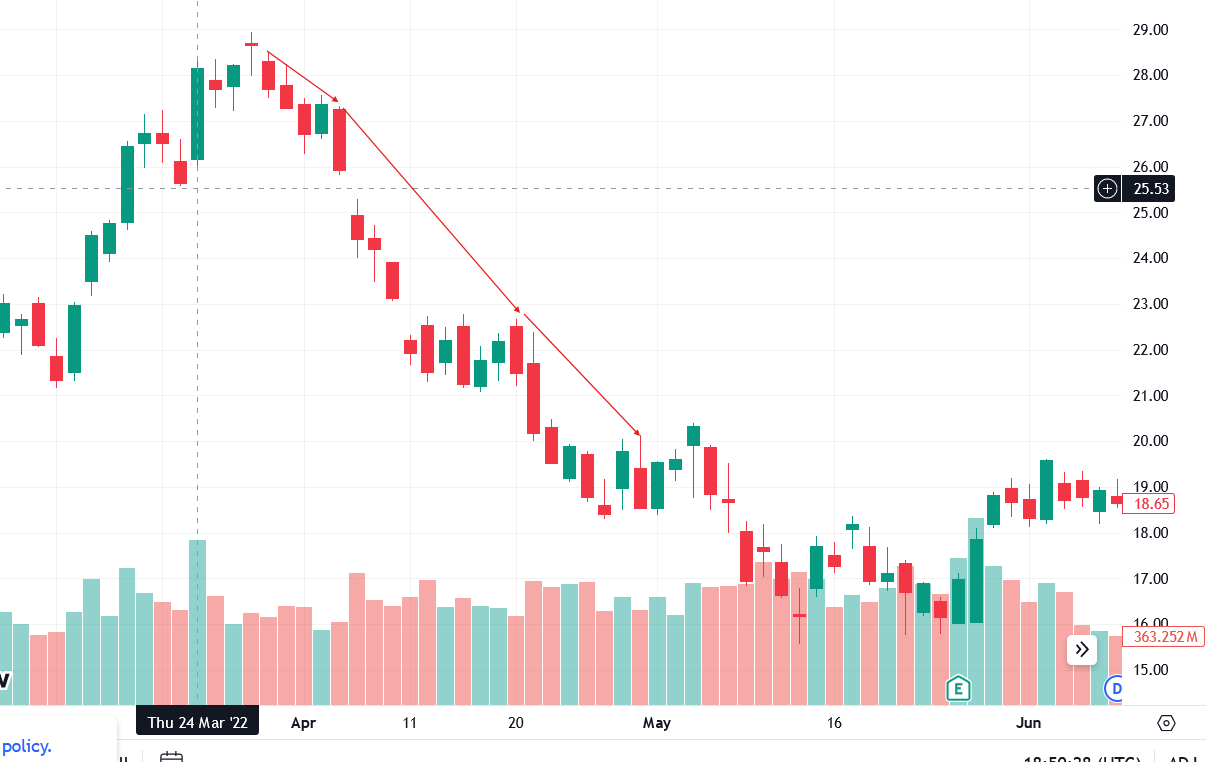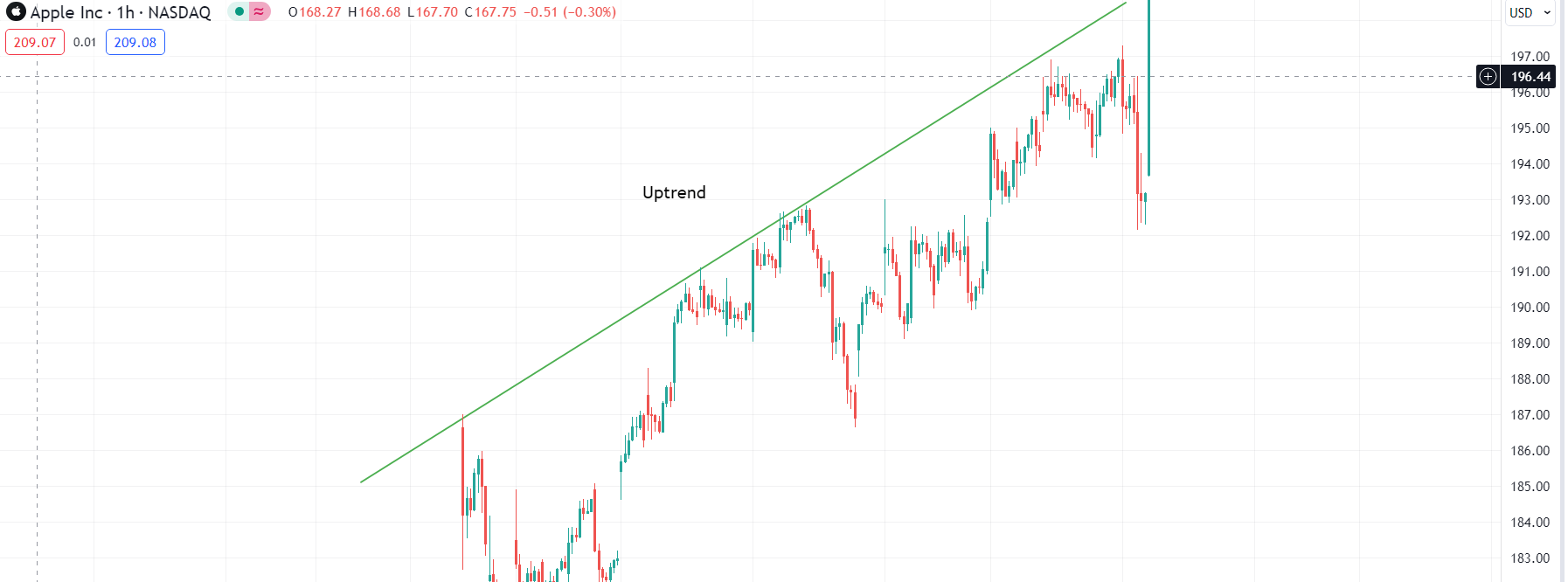Trend Lines

In today's financial world, trend lines are essential for technical analysts who analyze market data and forecast future price changes. Analyzing distinct price levels allows analysts to identify market patterns, like a positive slope indicating an upward trend or a negative slope suggesting a downward trend. Based on specific data points, the trend lines play a critical role in pinpointing important support and resistance levels necessary for making informed trading choices.
Trend lines show market trends visually and help grasp the momentum and possible turning points in price movements. Analysts depend on these lines to develop strategies and enhance the accuracy of their predictions. In the article below, we will define a trend line and its characteristics. This will help you learn how to draw trend lines precisely on price charts and utilize them efficiently in technical analysis.
Table of contents:
Key Takeaways
What Is a Trendline?
What Do Trendlines Tell You?
Example Using a Trendline
The Difference Between Trendlines and Channels
Limitations of a Trendline
Bottom Line
FAQs
Key Takeaways
-
Visual Tool: Trendlines help traders visualize market trends by connecting high or low points.
- Identify Levels: They highlight support and resistance levels, indicating potential price pauses or reversals.
- Signal Points: Trendlines can indicate potential entry and exit points for trades.
- Trend Analysis: Useful for identifying trend reversals or continuations, aiding in market momentum assessment.
- Limitations: Subjective drawing, false signals in volatile markets, and don't account for external factors.
What Is a Trendline?
Most traders define a trendline as the line drawn on a chart to link two or more price points. This line on a price chart is used to assist in recognizing and verifying market trends. In technical analysis, traders utilize trendlines as essential instruments to predict the overall direction of price fluctuations. They can be plotted above pivot highs or below pivot lows to indicate the dominant price direction. Trendlines visually show support and resistance levels on various time frames, helping traders anticipate possible reversal points and the general trend direction. Trendlines assist traders in making informed decisions and avoiding false signals by linking higher lows in an uptrend or lower highs in a downtrend.
What Is an Uptrend Line?
An upward trend line is a type of trendline shaped by connecting two or more lowest points on a price chart. Its main characteristic is a positive slope. Moreover, for the line to be considered valid, the second low has to be greater than the first one, and there must be a minimum of three points connected. This trend line functions as support, showing that net demand grows as the price goes up.
The increasing price and rising demand, for example can indicate a bullish market trend and firm buyer resolve. As long as the price stays above the upward trend line, the trend is seen as strong. A drop under this line indicates reduced demand and a potential shift in direction. Traders utilize upward trend lines to create trend lines that assist in recognizing and confirming market trends, offering crucial information for making well-informed trading choices.

What Is a Downtrend Line?
A downtrend line is created by connecting multiple high points on a price chart and has a slope that is negative. For the line to be considered a valid trend line, the second peak must be lower than the first, and a minimum of three points must be connected. Downtrend lines serve as barriers to price increases, suggesting that despite the price decrease, there is a growing supply.
The simultaneous decrease in price and increase in supply indicates, for example, a very negative market sentiment, reflecting the determination of sellers. While prices stay under the downtrend line, the general trend remains strong and unchanged. A breach beyond the downtrend line indicates a decreasing net supply and a potential shift in trend.
Traders use downtrend lines to forecast market trends and make strategic selling choices. They recognize that these lines usually indicate a gradual decrease in prices over varying time periods.

What Do Trendlines Tell You?
A descending trend line is a vital instrument technical analysts employ in ascertaining the present trajectory of market prices. It is formed by joining multiple high points on a price chart and displays a downward slope. To have a legitimate trendline, the second peak must be below the first one, and a minimum of three points must be marked.
Downtrend lines serve as barriers of resistance, showing a rise in overall supply as prices decrease. This signal indicates bearish sentiment, demonstrating significant selling pressure. The general trend is deemed unchanged if the price stays under the downtrend line. Breaking above the downtrend line indicates a decrease in net supply and a possible reversal of the trend.
Analysts utilize different time intervals, ranging from minutes to weeks, to create these lines and forecast market trends. Analyzing the variations in prices and slopes, whether up or down, gives analysts the information they need to decide whether to sell or hold onto their investments.
Example Using a Trendline

Using trendlines is quite simple. A trader plots the price data using open, close, high, and low prices. For example, look at the Apple stock in a candlestick chart with a trendline connecting session highs across a two-month timeframe.
This upward-sloping line indicates a bullish trend and can serve as a potential support level for initiating a trade. In this situation, a trader could decide to open a long position close to the trendline and continue it in the upcoming period. If the price breaks below the trendline, it indicates to the trader to exit the position, suggesting that the trend is losing strength.
The time frame utilized determines trendlines. In this example, there is no requirement to redraw the trendline frequently. Nevertheless, technical analysts may have to modify trendlines and trades more often on shorter time frames, like minutes, to accommodate fast fluctuations in market prices and trends.
The Difference Between Trendlines and Channels
Multiple trendlines can be added to a chart to form channels, visually showing support and resistance levels during the analyzed timeframe. A line linking high points and another linking low points, for example, can create a channel that shows the range in which the price fluctuates. This technique assists traders in forecasting possible breakouts or surges in price movements. Depending on the trading strategy, when the price movement breaks out of the channel, it may indicate a potential entry or exit point.
Channels, as opposed to individual trendlines, provide a more precise indication of the overall trend by considering both support and resistance levels. Traders generally utilize them to reduce incorrect signals and improve forecasting of market trends. Channels can be used on various time frames, and their efficacy can be increased by incorporating additional indicators such as moving averages. This method aids in comprehending the linear or exponential trends that depict the market's evolution over time.
Limitations of a Trendline
Although trendlines are beneficial for technical analysis, they do have their constraints. Novices need to realize that trendlines are subjective, as their precision depends on the proficiency of the trader drawing them, which differs among traders. They can also produce inaccurate signals in turbulent markets, potentially leading to financial losses. Experienced traders must realize that trendlines do not consider external factors like economic news or market sentiment, which can significantly impact price changes. Moreover, paying excessive attention to trendlines could lead to overlooking opportunities if other technical indicators or fundamental analysis are ignored.
Bottom Line

Trend lines are essential for technical analysts to analyze market data and forecast price trends. By plotting specific price points, analysts can identify upward or downward trends represented by positive or negative slopes. Trend lines help pinpoint support and resistance levels, which are crucial for making informed trading decisions. Although trend lines need periodic adjustments with new data, channels—formed by multiple trend lines—provide a broader perspective by highlighting both support and resistance levels. Combining trend lines with indicators like moving averages offers a comprehensive understanding of market trends and enhances trading strategies.
FAQs
Who Uses Trendlines?
Most technical analysts prefer to use trendlines to assess market trends, spot possible trading opportunities, and notice sudden price changes. Moreover, traders and investors utilize this efficient tool to make well-informed decisions.
What Should Traders Do When a Trend Line Breaks?
If a trend line is breached, traders must promptly reassess their positions. Based on the breakout direction and their trading strategy, this could be seen as a potential signal to either begin a new trade or exit an existing one.
What Are Stock Trend Lines Used for?
Stock trend lines are used to determine the overall direction of stock prices, identify patterns, and establish necessary support and resistance levels, helping traders make informed trading decisions.
What Are Internal Trend Lines And How Are They Useful?
Internal trend lines are sketched between significant price highs and lows to identify shorter-term trends and potential price reversals, offering traders valuable information on more accurate entry and exit points.
What Are the Different Kinds of Trendlines?
Trendlines are uptrend lines (showing price increase), downtrend lines (showing price decrease), and horizontal trendlines (showing stable prices and support/resistance levels).
